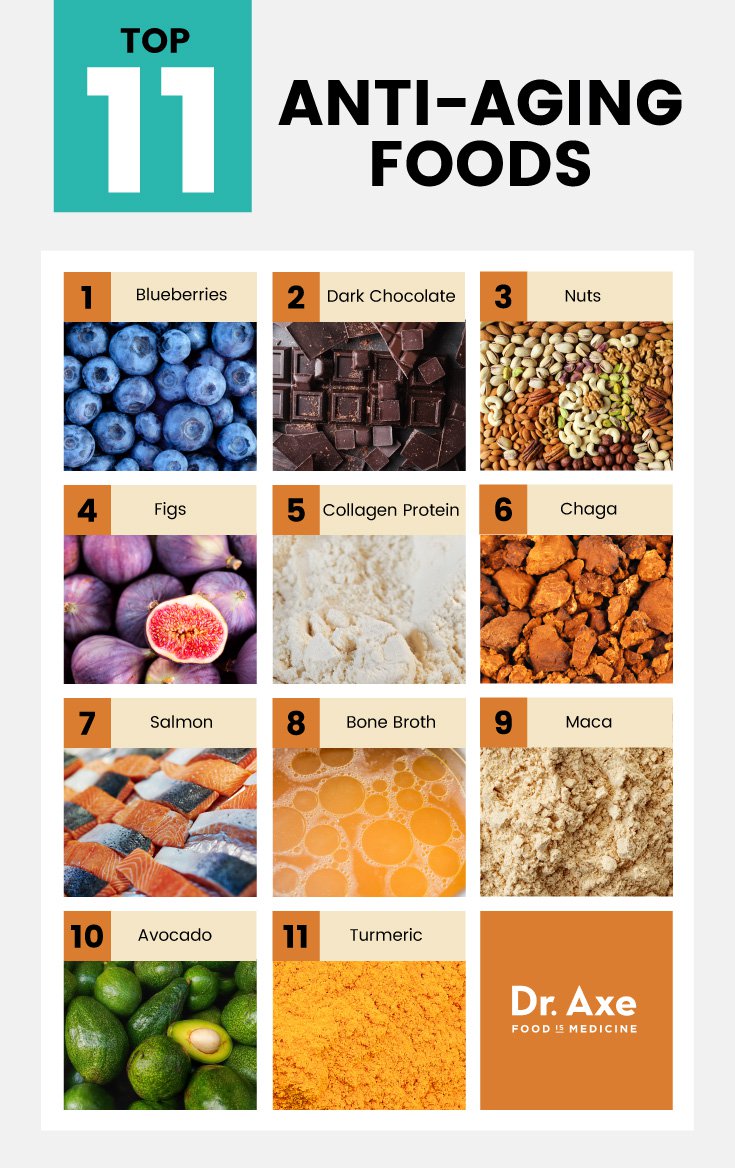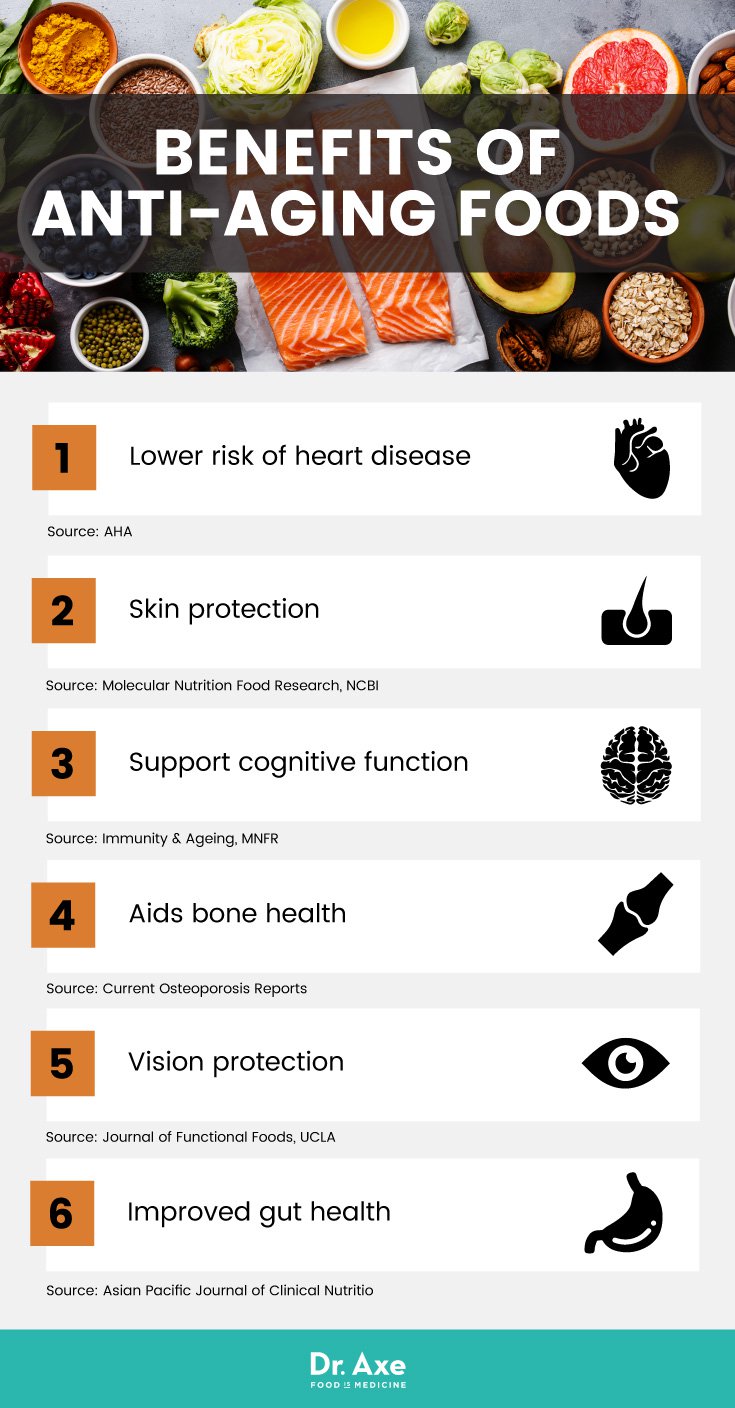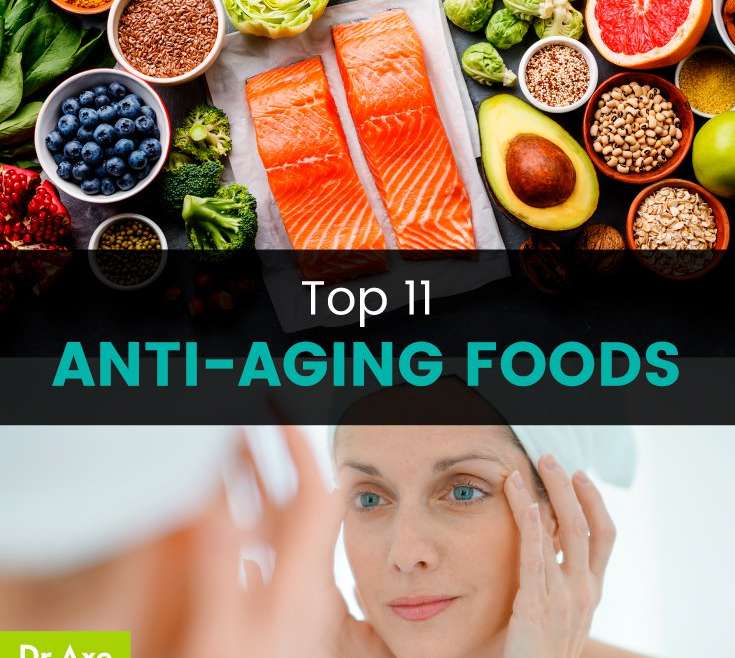How do you naturally slow aging? It’s a question that’s been asked for centuries. In fact, attempts to combat or reduce the effects of aging have dated as far back as mankind itself. Most people want to look and feel young, driving experts to invest many hours and thousands of dollars into finding silver bullet anti-aging formulas. While there isn’t a special formula that magically erases the wrinkles away, incorporating certain anti-aging foods into your diet is the best way to help bring you closer to that goal.
These delicious and nutritious foods will help slow the effects of aging in every part of your body — from your skin to your brain, heart and joints. So what are the top anti-aging foods, and what exactly do they do in order to keep your body feeling young and healthy? Well, the top anti-aging foods are also some of the most prominent high-antioxidant foods and anti-inflammatory foods around too.
Top 11 Anti-Aging Foods
- Blueberries
- Dark Chocolate
- Nuts
- Figs
- Collagen Protein
- Chaga Mushrooms
- Salmon
- Bone Broth
- Maca
- Avocado
- Turmeric
1. Blueberries
Blueberries have been shown to delay aging and promoting longevity. Most research on the health benefits of blueberries focuses on their cognitive benefits, protecting memory-associated regions in the brain from oxidative damage and slowing age-related damage to brain cells. (1)
Blueberries are rich in anthocyanins, a compound credited for its anti-agingeffects, limiting cellular damage caused by of free radicals and preventing a large array of ailments.
2. Dark Chocolate
The 2010 Dietary Guideline Committee concluded that adding moderate amounts of dark chocolate in addition to a healthy, balanced diet can provide anti-aging benefits. Since dark chocolate is high in calories, eating a small piece of chocolate with the highest percent of cacao (70–90 percent) is enough to help slow the effects of aging, according to research published in Antioxidants & Redox Signaling. (2)
3. Nuts
Eating nuts as part of a balanced diet can add years to your life by helping prevent chronic disease, such as cancer, cardiovascular disease and cognitive decline. Nuts contain both monounsaturated and polyunsaturated fats, and both compounds have been associated with reduced heart disease and type 2 diabetes risk. Because all vascular factors have been related to cognition, nuts may have the potential to slow cognitive decline in older adults. (3)
Some of the best nuts to consume for anti-aging include chestnuts, walnuts, pecans and more.
4. Figs
Figs nutrition is rich in flavonoids and polyphenols, which are responsible for strong antioxidant properties that help prevent various of oxidative stress-related medical conditions, such as hepatic and neurodegenerative issues. (4)
5. Collagen Protein
Collagen is the most important and abundant protein in the body, keeping it healthy and young for a long time.
For instance, research from Beijing University’s Department of Food and Nutritional Hygiene at the School of Public Health in China investigated the protective effects of marine collagen peptides (MCPs) on the skin of aged mice. Researchers concluded: “The results showed that MCPs might play a protective role on skin aging by improving the activity of antioxidant.” (5)
Further research published in the Journal of the Science of Food and Agriculture found that “MCP supplementation could promote the development of long bones in growing male rats.” (6)
In addition, marine collagen, with its high antioxidant content, has been used in beauty products in order to repair or prevent damage caused by environmental factors or aging process. (7)

6. Chaga Mushrooms
Chaga mushrooms produce a diverse range of active components, such as antioxidants, antitumoral and antiviral properties. They also hold compounds for improving human immunity against infection of pathogenic microbes. (8) The polyphenols in chaga are the principles for quenching free radicals, making these mushrooms protective antioxidants, according to research published in the Journal of Agricultural and Food Chemistry. (9)
7. Salmon
Salmon has high amounts of astaxanthin, a super antioxidant and carotenoid known for its unique anti-aging benefits. Astaxanthin is produced by algae, bacteria and fungi, and it concentrates higher up the food chain as these primary producers are consumed for food.
In a study, this substance inhibited oxidative damage to DNA by reducing C-reactive protein and strengthening the immune system. Astaxanthin increased HDL cholesterol and decreased triglycerides by improving circulation of blood. Astaxanthin’s clinical success extends beyond protection against inflammation and oxidative stress, making it useful to prevent or slow the signs of aging. (10)
8. Bone Broth
Bone broth seems to be very popular these days, especially when concerned with bone health. According to the Weston A. Price Foundation, bone broth contains minerals in forms that your body can easily absorb, including calcium, magnesium, phosphorus, silicon, sulphur and others, which are important for bone health. It contains chondroitin sulfate and glucosamine, the compounds sold as expensive supplements to reduce inflammation, joint pain and arthritis. It is best to check the label to ensure the bones come from grass-fed meats, so you can get the full benefits from these nourishing bones. (11)
9. Maca
Hormonal decline is a common biomarker of aging. Maca balances and normalizes the steroidal hormones estrogen, progesterone and testosterone. In South America, maca root is even used to improving sexual dysfunction, preventing osteoporosis, enhancing fertility and relieve menopausal symptoms. (12)
10. Avocado
Avocado has been in the spotlight recently as a superfood, containing phytochemicals and important essential nutrients to prevent the negative effects of aging. Avocados are packed with monounsaturated fatty acids and antioxidants, which are key compounds into keeping your arteries healthy and young. (13)
11. Turmeric
Turmeric has anti-aging and skin-lightening properties, and it has been used in cosmetics formulations for centuries. According to extensive research, including studies published in Immunity & Ageing, the curcumin in turmeric may help against aging of the joints, brain and other neurodegenerative conditions. (14)
How Anti-Aging Foods Slow Aging
There is substantial literature linking nutrition to aging. Aging is manifested by decreasing status of health and increasing chances to acquire age-related diseases, such as Alzheimer’s disease, atherosclerosis, cancer, diabetes and other conditions. Oxidative stress has been shown to be a major factor in the aging process, leading to inflammation and further degradation of healthy cells.
Inflammation is the body’s the natural immune response to anything it recognizes as a threat, and the reaction is meant to protect your health. Without a certain degree of inflammation, your health would be at risk from invading bacteria, fungi and viruses. Some foods, such as refined carbohydrates, sugary foods and red meat, can cause inflammation in your body, so eliminating or reducing them in your diet can keep you healthier and reduce the signs of aging.
Slowing down the aging process and delaying the onset of age-related conditions may be possible by blocking pathways that lead to inflammation. Fortunately, the healthy foods that fight inflammation are appetizing and easily accessible. Your best chance to live an active and long life is to avoid unhealthy foods that cause inflammation and learn about which foods provide proper nutrition and antioxidants to help fight disease. Anti-aging foods have proven beneficial at a microlevel or provide protection against degenerative conditions, guiding you toward a healthier road of successful aging and better health. (15)
Benefits of Anti-Aging Foods
- Lower risk of heart disease
- Skin protection
- Support cognitive function
- Aid bone health
- Vision protection
- Improved gut health
1. Help Lower Risk of Cardiovascular Disease
A randomized controlled study showed that consuming avocado a day along with a heart-healthy diet helps lower plasma LDL levels in obese and overweight participants. In double-blinded, randomized controlled trials, astaxanthin lowered oxidative stress levels in obese and overweight subjects and smokers. (16)
2. Skin Protection
Free radicals are the main destroying factors of skin. To stimulate the skin to build and repair itself, antioxidants in food help defend skin from the harmful action of free radicals and prevent degenerative disorders resulting from oxidative stress. (17)
Anthocyanins in blue blueberries have been reported to reduce the ultraviolet ray-induced skin photoaging effect as well as inhibiting collagen destruction and inflammation. (18)
3. Support Cognitive Function
In a small clinical trial, astaxanthin improved cognitive function, and in several Japanese RTCs, it improved visual acuity and eye accommodation. Curcumin, the main compound found in turmeric spice, can help keep your mind young. Curcumin is highly lipophilic and might cross the blood-brain barrier in sufficient concentrations. For this reason, studies suggest the lipophilic nature of curcumin maybe responsible for the significant reduced prevalence of Alzheimer’s disease in India compared to the United States.
In Singapore, elders who ate curry and turmeric had higher mini-mental state examinations scores than non-consumers. Nutritional antioxidants, such as the polyphenols found in blueberries, can also reverse age-related declines in neuronal signal transduction as well as cognitive and motor deficits.

4. Aid Bone Health
Eating a variety of antioxidant, anti-inflammatory and anti-aging foods can do wonders for bone health. For instance, consuming bone broth along with vitamin C foods and vitamin K foods can help strengthen bones and prevent bone loss, as learned through observations from the Framingham Osteoporosis Study. (19)
5. Vision Protection
Age-related macular degeneration (AMD) is characterized by chronic and progressive degeneration of photoreceptors. There have been studies showing the carotenoids lutein and zeaxanthin exist in high concentrations in the macula of the eye and protect the retina from oxidative stress. (20)
In a trial out of UCLA, AMD participants were instructed to take 60 milliliters of lutein-zeaxanthin complex beverage derived from marigold and wolfberries for five months. Inflammatory markers and oxidative stress index were lowered when these subjects consumed the beverage for five months. Consumption of antioxidants found in anti-aging foods may help suppress oxidative stress and reduce incidence of AMD. (21)
6. Improved Gut Health
Figs are a good source of fiber, which can help ease constipation. In a recent randomized, double-blinded, placebo-controlled trial, participants who were given fig paste supplements improved in constipation and abdominal discomfort compared to placebo. (22)
How to Use Anti-Aging Foods + Anti-Aging Foods Recipes
You can find anti-aging foods at your local supermarket or farmer’s market. To ensure you consume the freshest and most beneficial anti-aging foods, buy products that meet USDA Organic Standards.
Here are some anti-aging foods recipes to try:
- Treat your skin with a plate full of omega-3s and protein by serving grilled honey glazed salmon.
- Satisfy your sweet tooth with blueberry pudding.
- Enjoy a warm, delicious and anti-inflammatory-rich turmeric tea drink.
History
Cultures have taken advantage of natural components found in food, proving you can age well and gracefully without going under the knife or spending a fortune on anti-aging creams.
The Greeks and Romans applied poultices of corrosive sublimate of limestone, mustard and sulfur to the skin. Tree resins, such as myrrh and frankincense, were mixed with pumice to lighten the skin and remove freckles and wrinkles. During the Middle Ages, women would use old wine that had the active ingredient tartaric acid to achieve rejuvenation.
Lemon juice has been used as a brightening agents for as long as anyone can record across various cultures. Also in the Middle Ages, women treated acne with curdled milk (lactic acid), removed freckles with cucumber juice and produced an even, smooth complexion with boiled nettles. In Japan, a mask of nightingale droppings has been used for centuries. Initially, the droppings were used to bleach silk and then were later applied to the skin! The excrement was put out in the sun to dry and pulverized into powder — then the paste was applied to the skin and rinsed. (23)
In Egypt, the Egyptians valued the application of cosmetics and viewed makeup artists as highly skilled engravers. Interestingly, the ancient Egyptians concocted numerous formulations to be both cosmetic and medicinal. (24) Formulations were made from flowers, fruit, liver, lung, gut and wine. Women would use sour milk mixed with alabaster, animal oils and salt to help remove the external surface of the skin and enhance their beauty.
Precautions
If you were prescribed medication, you should not use curcumin or turmeric without first talking to your health care provider. Turmeric may interfere with the action of blood thinners, diabetic drugs or NSAIDS. (25)
Use of maca may be contraindicated in patients with fibroids, estrogen receptor-related cancer risk, endometriosis or prostate cancer.
Studies also suggest that chaga may interact with anticoagulant and hypoglycemic medication. (26)
Final Thoughts on Anti-Aging Foods
- The journey to looking and feeling young through anti-aging creams and surgery has been going on for years.
- Many incorporate anti-aging foods into their diets as a healthier alternatives to slow the effects of aging from the inside out.
- Benefits of anti-aging foods include aiding cardiovascular health, better vision, increased cognitive function, healthy gut function and skin protection.
- Anti-aging foods can be found at your local supermarket or can be ordered online.
- If you were prescribed medication, consult your healthcare provider before consumption as anti-aging foods can be contraindicated.
- The top 11 anti-aging foods are:
- Blueberries
- Dark Chocolate
- Nuts
- Figs
- Collagen Protein
- Chaga Mushrooms
- Salmon
- Bone Broth
- Maca
- Avocado
- Turmeric



